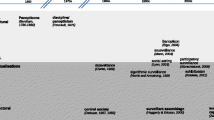Abstract
This paper investigates how are things on the street methodically displayed to exchibit an aspect of extra-legal ‘ownership'. Harvey Sacks proposed two categories of ownerships, those that one wants and can have and those that one wants but cannot have. Building on this Sacks’ categorizations and on his method of simple observation and on photographic documentation this paper develops an additional typology of informal ownership displayed on the street. Typology is based on the layperson’s unmediated inference of the in situ and in vivo account of the exhibited properties of a thing’s methodic display. Taking from Harold Garfinkel that social order resides in the ordinary practice the author’s layperson’s description of an observed thing accounts for the method of its display as the recognized generality of the ownership type. Such analysis escapes the sociological method of complex analysis of large collections of quantitative data as the only and privileged account of social order. In this regard, Sacks envisioned social analysis as natural science based on simple observations, reporting, and replications that could be done by anybody.
Similar content being viewed by others
Notes
The first photographs at any crime scene should show both the layout and the evidence within the scene ‘As Found’ before any alterations to the scene. Nothing should have been added to the crime scene; and nothing should have been taken away from the scene when the scene is first photographed. Another description of this is sometimes expressed as photographing the item of evidence ‘In Situ’ (Latin for ‘in place’): in the situation it was originally found before any movement” (Robinson, 2016: 69).
References
Eisenmann, C., & Lynch, M. (2021). Introduction to Harold Garfinkel’s ethnomethodological “Misreading” of Aron Gurwitsch the phenomenal field. Human Studies, 44(1), 1–17.
Garfinkel, H. (1984). Studies in ethnomethodology. Polity Press.
Garfinkel, H. (2002). Ethnomethodology’s program. Working Out Durkheim’s aphorism. Rowan & Littlefield Publisher INC.
Garfinkel, H. (2021). Ethnomethodological misreading of Aron Gurwitsch on the phenomenal field. Human Studies, 44(1), 19–42.
Garfinkel, H., & Wieder, D. L. (1992). Two incommensurable, asymmetrically alternate technologies of social analysis. In G. Watson & R. M. Seiler (Eds.), Text in context: Contributions to Ethnomethodology (pp. 175–206). Sage.
Goodwin, C (1994) Professional Vision. American Anthropologist, 96(3), 606-633.
Gurwitsch, A. (1964). Field of consciousness. Duquesne University Press.
Harper, D. (2012). Visual sociology. Routledge.
Lynch, M., & Bogen, D. (1994). Harvey Sacks’ primitive natural science. Theory, Culture & Society, 11(4), 65–104.
Merton, R. (1938). Social structure and anomie. American Sociological Review, 3(5), 672–682.
Miller, K. F. (2007). Designs on the public: The private lives of New York’s public spaces. University of Minnesota Press.
Robinson, E. (2016). The crime scene photography. Academic Press.
Sacks, H. (1963). On sociological descriptions. Berkeley Journal of Sociology, 8, 1–16.
Sacks, H. (1979). Hotrodder: A revolutionary category. In G. Psathas (Ed.), Everyday language. Studies in ethnomethodology (pp. 7–14). Irvington Publishers, Inc.
Sacks, H. (1984). Notes on methodology. In J. M. Atkinson & J. Heritage (Eds.), Structures of social action (pp. 21–27). Cambridge University Press.
Sacks, H. (1992) Lectures on conversation V. I, II. Oxford: Blackwell.
Shaftoe, H. (2008). Convivial urban spaces: Creating effective public places. Routledge.
Sharrock, W., & Anderson, B. (2011). The Ethnomethodologists. Routledge.
Streeck, J. (1996). How to do things with things. Human Studies, 19, 365–384.
Wittgenstein, L. (2001). Philosophical investigation. Blackwell.
Letters
Jefferson, G. February 25, 1988, 1–2.
Jefferson, G. March 15, 1988, 1–10.
Sudnow, D. December 18, 1987, 1–6.
Author information
Authors and Affiliations
Corresponding author
Additional information
Publisher's Note
Springer Nature remains neutral with regard to jurisdictional claims in published maps and institutional affiliations.
Rights and permissions
Springer Nature or its licensor (e.g. a society or other partner) holds exclusive rights to this article under a publishing agreement with the author(s) or other rightsholder(s); author self-archiving of the accepted manuscript version of this article is solely governed by the terms of such publishing agreement and applicable law.
About this article
Cite this article
Bjelić, D. An Exercise in “Primitive Natural Science” of Naturally Occurring Types of ‘Ownership’. Hum Stud 46, 137–161 (2023). https://doi.org/10.1007/s10746-022-09657-z
Accepted:
Published:
Issue Date:
DOI: https://doi.org/10.1007/s10746-022-09657-z




